Summary of my conclusion - you'd spot it gravitationally from effects on our spacecraft such as Voyagers 1 and 2 and New Horizon probably at a distance of 1000 au. If there was one within 1000 au already in 2003 then Pioneers 1 and 2 would have spotted it easily. At that distance even a hypervelocity black hole would take years to get here and a more typical black hole decades. You could also spot it by the effects on orbits of trans Neptunian objects. It would be a challenge to spot an old black hole visually unless it develops an accretion disk, though a young one with matter still falling into it would be easy to spot at vast distances. The whole scenario is absurdly improbable but this can help scared people who are afraid it can suddenly appear overnight.
In detail:
You wouldn't see anything like this
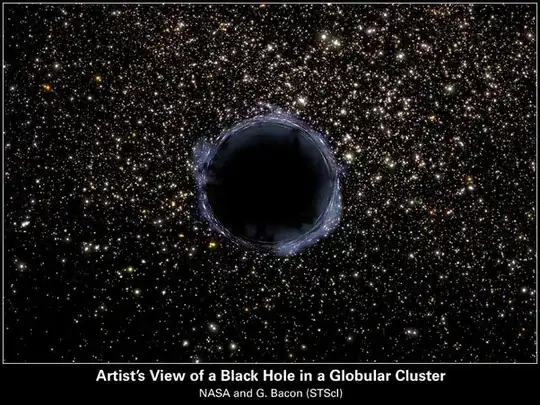
Artist's View of a Black Hole in a Globular Cluster
At Hubble’s resolution of a tenth of an arc second, or 1/36,000th of a degree, then a ten solar mass black hole 30 km in diameter would span a single pixel at a distance
2*π*r/(360*36000) = 30
so r= 30*360*36,000/(2*π) = 61,879,442 km or 61,879,442 km in au =
0.41 au
You would just see a brightening and then darkening as it passed in front of a distant star. You’d spot it by stellar occultation, notice that one of the numerous stars in your photograph blinked out for a while and then re-appeared. The way it did that would be distinctive, if it passed in front of distant stars.
It would pass in front of stars occasionally. Even if headed straight for Earth then Earth’s movement back and forth each year would cause it to change position relative to distant stars. But you have to be in the right place to see this. The footprint of the black hole as it passes in front of a distant star would only be 30 kilometers across on Earth’s surface and moving rapidly due to Earth’s spin and rotation. You’d have to be in just the right place on Earth to catch a glimpse as the star brightens due to the lens effect as the black hole passed in front of it.
This is a possible black hole lens event
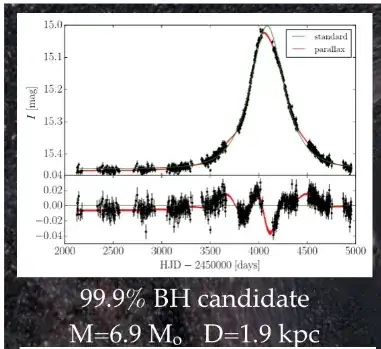
This is possible. It would be about the same size as Ultima Thule and they were able to map out its profile to high accuracy by using lots of observers watchiung out for its occultation. The white lines show the observations with gaps for the occultation and the blue shows the actual silhouette as found by New Horizons from close up observations
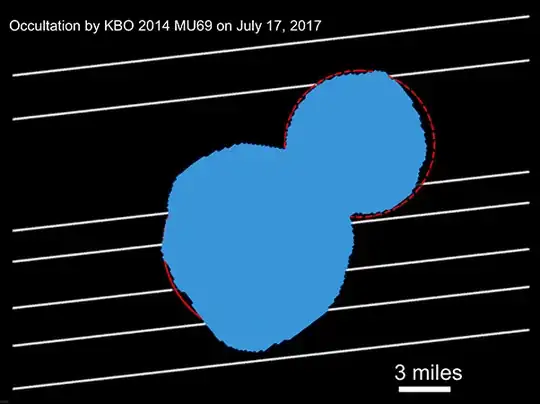
If we knew it was there we could study it in some detail like that. Work out when it is going to pass in front of some distant star, and then position observers to do the light curve tracks - and we could equip them with instruments to measure the variation in intensity and perhaps we could even map out its Einsteinien ring too in some detail from the variation in the brightness? This is a bit speculative, just a suggestion.
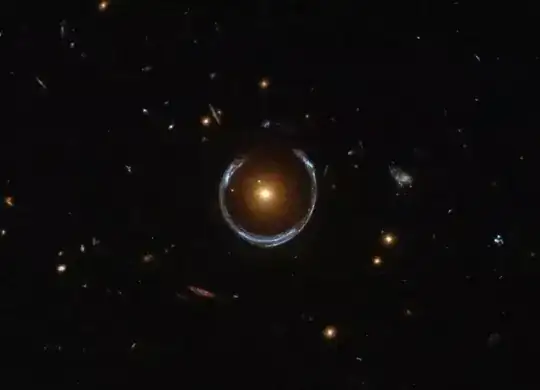
Einstein ring due to a distant galaxy that is lensed by a nearby massive galaxy
If a black hole passed in front of a distant star would get a really tiny Einstein ring, you wouldn’t see it in even the most magnified photograph because the ring would be smaller than a single pixel but perhaps you could spot it with occultation experiments if you knew it was there. APOD: 2011 December 21
You would notice the star dim and brighten as the black hole passed in front of it and from the shape and depth of the dimming you could infer a black hole. This might be a way to spot it if it passes in front of the dense star fields of the center of our galaxy and the Milky Way. Perhaps the Gaia star survey would spot it, for instance.
But if it comes from some other direction rather than the center of the galaxy, it’s not going to be easy to notice it visually in the first place.
HOW ELSE WOULD WE SEE IT?
So, how else could you notice it? A young black hole would be very easy to spot from the accretion disk. The accretion disk in Interstellar was altered to look visually symmetrical. Due to red shift and blue shift of the swirling accretion disk it would actually look like this:
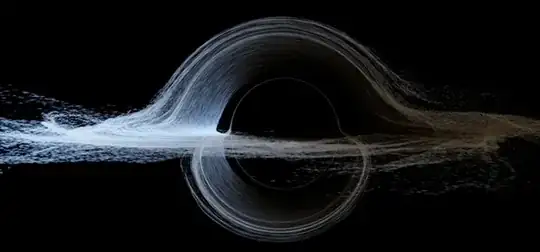
The Truth Behind Interstellar's "Scientifically Accurate" Black Hole
If this is a five or ten solar mass black hole, that whole thing would still be only a few tens of kilometers in diameter (the central dark patch might be double the 30 km diameter of the event horizon of the black hole), and less than a pixel in the sky. You wouldn’t see anything like that from a distance. But it would be very bright, emitting x-rays also and gamma rays and would be easy to spot from thousands of light years away..
So , we can’t miss a young black hole like that.
For an older one though
- If it forms an accretion disk from matter falling in from the Oort cloud. Not too likely to encounter many Oort cloud objects at 30 kilometers in diameter though. Maybe from the gas and dust in the Oort cloud?
The gravitational effects seem most likely as the way to notice it.
NOTICING IT GRAVITATIONALLY USING OUR SPACE PROBES
Our most sensitive gravitational probes are the two Pioneer space probes, the two Voyyager space probes and New Horizons.
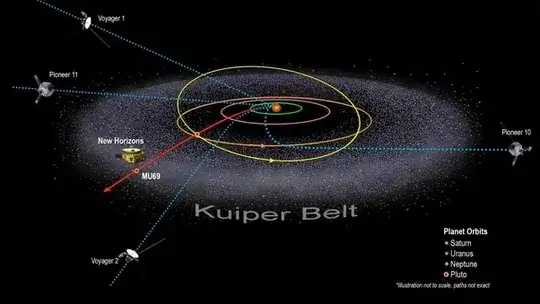
The PI’s Perspective: Why Didn’t Voyager Explore the Kuiper Belt?
These are very sensitive gravity probes. The Pioneer anomaly was a reduction in speed of only 1 km / hour over ten years of a spacecraft traveling over 12 kilometers per second.
They were particularly sensitive because they did no course corrections. They eventually explained this anomaly as a thermal effect.
Clearly no black holes were anywhere near the solar system at the time of the last observations 2003, when we lost contact with them, because it would have a larger effect than this.
We are also tracking the two Voyager probes, which are still in contact, and the New Horizons probe. They also are very sensitive probes but not as sensitive as Pioneer.
A five solar mass black hole is probably around the smallest size of a black hole created in a supernova. It could perhaps be a smidgen smaller, maybe down to 4 or less but no such black hole has yet been found. See Stellar black hole.
The distance where the black hole has equal gravitational effect to the sun is when the distance to the black hole is about twice the distance from the probe to the sun.
An acceleration like that would surely be very noticeable for any black hole that close.
Which suggests that we could easily spot a black hole up to the same distance aany of these probes in the oppositee direction.
For instance, Voyager 2 is 120 au away. We’d surely spot the gravitational effect of any five solar mass black hole at up to as 120 au from the sun in any direction on Voyager 2, or on Voyager 1, unless it was at right angles to both paths, in which case it would have had an effect on Pioneer 10 for sure.
On this basis I think the closest an undetected black hole could be is likely to be hundreds of au. Pioneer spotted an anomaly of(8.74±1.33)×10^−10
m/s2
So at what distance would an object five times the mass of the sun have that much of an effect?
g=GM/r^2
r = sqrt(GM)/g
Using G = 6.674*10^-11
M = 5 × 1.9891 × 10^30 (five times mass of sun)
r = sqrt(6.674*10^-11*5*1.989 *10^30/((8.74*10^−10))
gives 8.7144459*10^14 meters or 8.7144459*10^14 meters in au = about 5,825 au.
So, it looks as if eiher of the Pioneer probes could have spotted a black hole up to 5,825 au away.
The gravitational anomaly goes down as the square of the distance, so they’d spot a hundred times the anomaly at 580 au.
There is no way they missed a hundred times this anomaly. Or to go for a round number, there is also surely no way they’d miss a black hole as close as 1000 au either, which would be 34 times larger. The only possibility would be a black hole in a direction at right angles to both. But though I am not sure how to calculate how much of an anomaly the Voyagers or New Horizon would spot, I’d be surprised if they couldn’t notice a black hole within a few hundred au.
So, I think we can be reasonably confident there isn’t an old five solar mass black hole currently within a few hundred au of Earth and unlikely to be one within a thousand au.
NOTICING IT GRAVITATIONALLY WITH OBSERVATIONS OF SEDNA AND OTHER TRANS NEPTUNIAN OBJECTS
We also have the many objects we are tracking such as Neptune, Sedna, Eris and all the other trans plutonian objects. We’d certainly notice if there was an object within four times the distance to those objects because at that distance its gravitational effect would exceed the effect of the sun.
There are many such objects. They are part of the evidence for the possible “planet 9” way out far beyond Neptune.
YouTube Video
An object, say, at the same distance from us as Sedna in any direction with five times the sun’s mass would have more effect on it than the sun so surely that would be very noticeable.
The >gravitational attraction depends on the square. If it is the same distance from the sun as Sedna in any direction, that means it is at most twice the distance from Sedna as the sun, and so, has 5/4 of the sun’s gravitational effect, so, more than the sun.
I’m not sure how long you’d need to track Sedna to notice but I think you’d notice it within weeks.
So that would suggest we’d notice a black hole at least 80 au away easily through its effect on objects like Sedna.
It doesn’t even have to be in the same direction as Sedna. In any direction you’d notice.
Also there are many of these objects now that we are tracking.
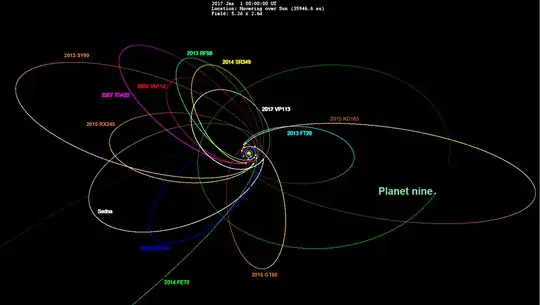
File:Planet nine-etnos now-new2.png
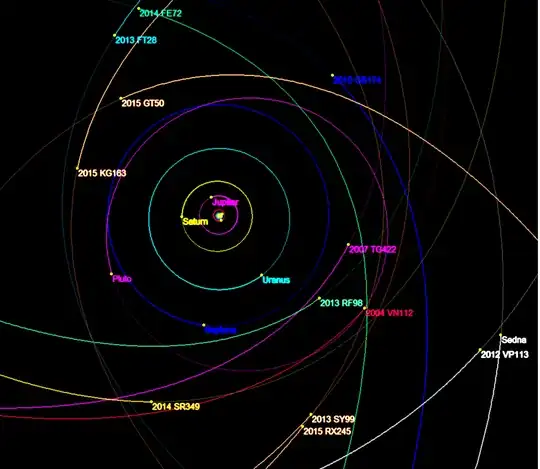
File:Planet nine-etnos now-close-new.png
That’s just a selection of some of the ones with the most extreme orbits taking them far from the sun. We now know of over 2500 trans Neptunian objects - ones with the semi-major axis (half the “length” of the ellipse) at least as large as Neptune’s.
List of trans-Neptunian objects - Wikipedia
We’d surely notice the gravitational effects of a five or ten stellar mass black hole on them.
But the planetary probes would probably notice it up to ten times further away.
THIS IS AN ABSURDLY UNLIKELY SCENARIO - CALCULATION OF THE ODDS
It is also absurdly unlikely. Only one star in a thousand is a black hole. The nearest star is over 4 light years away. Let’s look at our neighbourhoood out to 5 parsecs, or 16.3 light years.
It includes 67 stars including white dwarfs:
- 50 red dwarfs
- 13 larger stars like our sun
- 4 white dwarfs
That makes it 0.067 black holes.
For a 50% chance of a black hole, then you need to go out to 16.3*(0.5/0.067)^(1/3) or around 32 light years.
To work out what the chance is of a black hole getting as close as Neptune, I’ve found a way to do an exact calculation
There's a formula, we can use here, from Perturbation of the Oort Cloud by Close Stellar Approaches.
Our sun has approximately 4.2*D^2 encounters with other stars every million years.
There D is the diameter in parsecs of the spherical region around the star.
Neptune's semi major axis is 4.49506 billion kilometers so it's diameter is around 0.00029135 parsecs. So substituting that for D, every million years there is 1 chance in 2.8 million (calculated as 1/(4.2*0.0002913^2)) of a star passing closer to the sun than Neptune.
One star in a thousand is a black hole so that makes it 2.8 billion to one for a black hole in any million year period.
For a century then that makes it 28 trillion to one for a black hole to get as close as Neptune.
HOW LONG WOULD IT TAKE A BLACK HOLE TO GET TO THE SUN OR EARTH FROM AN UNDETECTABLE DISTANCE?
With such low probabilities it is clearly not something to worry about. If you are still worried you may be influenced by movies. See my
But I help people who have got so scared by the ridiculous black hole YouTube movies that they are scared to go outside their house because they think they will see it in the sky. Videos like this one:
What if A Black Hole Hits The Earth?
So, how long would it take to travel a thousand au, or even, 160 au?
We then need the speed of the black hole.
Black holes are just stars that collapse to a black hole at the end of their life. Neutron stars have a bit of a natal kick at birth. But the supernova that leads to a black hole has a much larger star to kick, 10 solar masses, and more of the mass ends up in the black hole eventually.
They are probably traveling at similar speeds to other stars in our area. So for instance the fastest black holes may be the same as the fastest stars. The fastest nearby star is Barnard’s star (around 6 light years away) at 140 kilometers per second. At that speed it could travel the distance of 30 au from Neptune to the Sun or Earth in about a year.
140 kilometers per second in au per year = 29.5 au per year
It’s hard to quantify but probably most black holes don’t have much of a natal kick. Christopher Berry discusses this here
- Accuracy of inference on the physics of binary evolution from gravitational-wave observations
In any case young black holes would be easy to see, so we only need to consider older ones. If given a big kick it may be ejected from our galaxy or at least be in an orbit that takes it out of the disk or much furhter from the center of the galaxy for most of its time.
If it is traveling the same speed as Bernard’s star then it travles the 160 au in about 5 years and the 1000 au in about 33 years.
So, likely to be several decades for it to get to our vicinity from when first detected.
The fastest hypervelocity stars, very rare, travel at 1200 km/ sec and that’s more than the galactic escape velocity (around 500 km / sec). Even at that speed of 253 au per year, it would travel 1000 au in around 4 years. So even a hypervelocity black hole couldn’t sneak up on us in less than four years. One of our spaceprobes would surely spot the gravitational effects.
Phil Plait’s 500 miles per second black hole would travel 170 au per year so would take getting on for six years to get here from 1000 au away.
If you have an idea of how to fill in the details of these calculations and get more precise answers do say!
But this is enough to help those who are scared to leave their house thinking they may see a black hole approaching in the sky.
They know it is irrational. But they have this idea “improbable things can happen” which I think comes from movies, and to know that it is impossible for a black hole to sneak up on us is a comfort to them when in the middle of one of these panic attacks.
I have a slightly longer version of this here as a Quora answer which I did first then trimmed down a bit and copied into this Stack Exchange answer:







